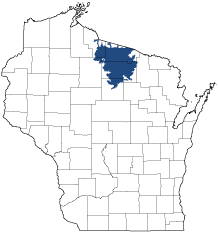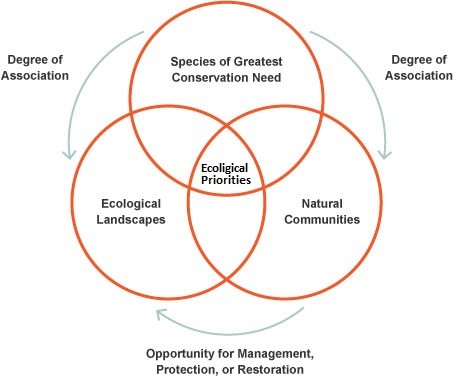Northern Highland
Ecological Landscape
The Northern Highland chapter [PDF] of the Ecological Landscapes of Wisconsin book provides a detailed assessment of the ecological and socioeconomic conditions for the Northern Highland.
It also identifies important planning and management considerations and suggests management opportunities that are compatible with the ecology of the landscape. The sections below provide additional information.
- Physical and Biotic Environment
-
Physical and Biotic Environment
Size 2,081 square miles (1,331,970 acres), representing 3.7% of the total land area of the State of Wisconsin. Climate Typical of northern Wisconsin, with a mean growing season of 122 days. The mean annual temperature is 39.5 deg. F is the lowest of any Ecological Landscape in the state and almost 2 degrees lower than other northern ecological landscapes. The mean annual precipitation is 31.6 inches, similar to other northern ecological landscapes. The mean annual snowfall is 68.1 inches, the second-largest amount of snowfall in the state. Only the Superior Coastal Plain receives more snowfall (87.4 inches). Snowfall varies dramatically within the Northern Highland, with the northern part of the Ecological Landscape being within the outer edge of the lake effect "snowbelt" of Upper Michigan and northwestern Wisconsin. The cool temperatures, short growing season, and sandy soils are not adequate to support agricultural row crops, such as corn. Only about one percent of the Northern Highland is used for agricultural purposes. The climate is favorable for forests, which cover more than 76% of the Ecological Landscape. Bedrock Predominantly igneous and metamorphic rock, generally covered by deposits of glacial drift from 5 to over 100 feet in depth. Geology & Landforms Most of the Ecological Landscape is an undulating, gently rolling glacial outwash plain with many kettle lakes, wetlands, and bogs. Remnant moraines and drumlins occur often, with their lower slopes covered with outwash sands. Soils Most soils are sands and gravels, some with a loamy mantle. Soil productivity is low compared to glacial till but relatively high for outwash sands. Wetlands are numerous; most have organic soils of peat or muck. Hydrology There is a globally significant concentration of glacial lakes in the Northern Highland: 4,291 lakes; 1,543 miles of streams, including the headwaters of the Wisconsin and Manitowish-Flambeau-Chippewa river systems. Many lakes are connected by small streams. Rare aquatic species and extensive wetlands (see below) occur here. Current Landcover 48% upland forest, 34% wetlands (both forested and non-forested), 13% open water, 5% grassland and open land, and 1% urban. - Associated Rare Species and Natural Communities
-
Associated Rare Species and Natural Communities
Species of Greatest Conservation Need (SGCN) are associated with habitats (or natural communities) and places on the landscape. Understanding relationships among SGCN, natural communities and ecological landscapes help us make decisions about issues affecting SGCN and their habitat and how to respond. Download the Wildlife Action Plan association score spreadsheet to explore rare species and natural communities associated with this ecological landscape.
- General Management Opportunities
-
General Management Opportunities
The Northern Highland is especially rich in rare species associated with waters and wetlands, including some of the north's most iconic animals, such as the Bald Eagle, Osprey and Common Loon. There are major opportunities to protect aquatic ecosystems, including one of North America's highest concentrations of glacial lakes, some of which are rare lake types. Lakes connected by perennial streams are common here and support a diverse aquatic fauna that includes rare and uncommon species. Protecting undeveloped lakes, restoring disturbed shorelines and protecting the integrity of lake-stream complexes are all extremely important management opportunities. Maintaining forest cover around and between lakes and streams is also needed to maintain high water quality and provide habitat for numerous species.
The landscape's rivers and streams provide critical habitats and support many rare species. Significant protection and management opportunities include the headwaters region and upper stretches of the Wisconsin River, as well as the Manitowish, Tomahawk and Squirrel rivers. A concentration of springs and spring ponds in the northeastern part of the Northern Highland-American Legion State Forest offers management opportunities for aquatic species associated with coldwater systems.
The extensive forests here present major opportunities and include the state's greatest acreage of dry-mesic white pine-red pine forests. These could be managed in the wide range of patch sizes, age classes, seral stages and environmental settings characteristic of the Northern Dry-mesic Forest community in this landscape. Other less abundant forest types providing good management opportunities include mesic hemlock-hardwood and northern hardwood forests; swamp conifers of black spruce, tamarack, or white cedar; dry jack pine forests; and hardwood swamps. Red oak, important for both ecological and economical reasons, is now a major forest component in some areas. Paper birch is declining, and regeneration has proven difficult on many sites in the absence of fire. Extensive public ownerships create opportunities to manage these forests at large scales within and across ownerships.
Old forests, a rare and declining resource in Wisconsin, present important opportunities for white pine, red pine, red oak, hemlock hardwoods, northern hardwoods and swamp conifers. Working forests, both public and privately owned, could include areas with extended rotations, the development of old-growth forest characteristics and/or stands of "managed old-growth."
The Northern Highland historically consisted of a diverse mosaic of habitats, patch sizes, stand ages, ecotones and aquatic features. Although management is often conducted at the stand level, there are major opportunities here to plan and coordinate management from a much broader perspective to accommodate all patch sizes and ages for forest communities. This would help maintain the full range of habitat diversity needed across the Ecological Landscape.
Abundant wetlands include several of the state's largest and least disturbed acid peatland ecosystems, as well as hardwood swamp, white cedar swamp, shrub communities, emergent marsh and wild rice marsh. These wetlands provide important habitats and are critical for maintaining water quality in the landscape's high-quality lakes and streams. Maintaining wetland hydrology and avoiding conversion to other wetland types is important and necessary to provide habitat for numerous wetland-dependent plants and animals.
- Considerations for Property Planning
-
Considerations for Property Planning
There has been a steady increase in both seasonal and permanent residents, creating a pattern of dispersed urbanization. This has been especially evident along shorelines, where habitat loss has occurred in the littoral zone and on lands adjacent to the shore. Residential development is also increasing in the forests which surround many lakes. Population growth and associated development appear likely to limit some management options in the future, such as the ability to manage at large scales, maintain ecosystem connectivity, protecting important spawning, nesting, and foraging habitats. Restoration of shoreline habitats and the processes that maintain them will become more difficult over time.
Several large industrial forest holdings have changed ownership in recent years. In some cases, these properties have been sold to public agencies, but they may also be sold to other industrial owners, real estate developers, or other private entities. When large contiguous ownerships are broken up habitat fragmentation is often one of the results, and this parcelization makes it difficult to meet the desires of all of the new landowners, potentially limiting management options. The development of seasonal and permanent homes, along with roads and other infrastructure to service the residents, has also increased habitat fragmentation and reduced the size of formerly connected habitats.
Excessive deer herbivory can suppress or eliminate the regeneration of trees such as hemlock and white cedar, and reduce populations of sensitive understory plants, including native plants in the lily and orchid families. The winter feeding of deer can lead to increased overwinter deer survival, larger deer populations than habitats can sustain, and ultimately, serious habitat damage.
Invasive species are present in both terrestrial and aquatic ecosystems. The "Clean Boats, Clean Waters" program and other educational efforts attempt to limit the introduction and spread of invasive species to aquatic habitats, but more awareness, persistence and follow-through are needed. In terrestrial ecosystems, some invasive species are present but most are not yet abundant enough to cause serious problems - making this the most effective time to initiate control measures.
- Maps
-
Maps
Printable maps of ecological landscapes are available in the Ecological Landscapes of Wisconsin document and map library.
Many of the map layers, such as Land Type Associations, Conservation Opportunity Areas and Finley’s 1800s vegetation polygons are available to download from the WI DNR GIS Open Data portal.


